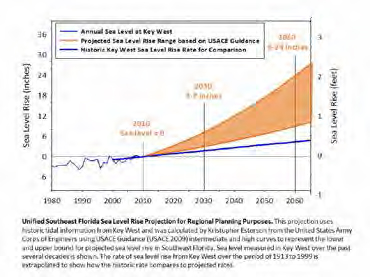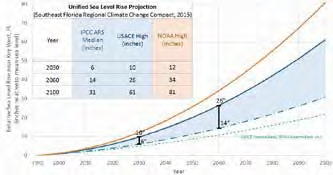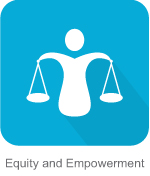 Executive Summary
Executive SummaryMonroe County is ranked third highest in the country for impacts of tidal flooding. Sea level rise will affect county residents through increased nuisance flooding, fluctuations in storm severity, and the resulting changes in our ecosystems and species populations. It will also affect average temperature levels, precipitation rates, and human health.
GreenKeys! is Monroe County’s plan for addressing climate change and sea level rise. It provides guidance for decision- makers as well as for county employees, residents, and business owners. With 165 recommendations and a 5-year work plan, GreenKeys! is a blueprint for increased sustainability and resilience to climate change.
GreenKeys! contains six focus areas aligned with county priorities for future planning and project implementation:
 Sea Level Rise Scenarios
Sea Level Rise ScenariosUnder a high sea-level rise scenario of a 2-foot rise by 2060, nearly 36% of the population is projected to be displaced. The high sea-level rise scenario for 2100 predicts that 54.8% of the population will be affected by an increase in sea level of 2.7 feet and 83.1% affected with 5.4-feet of sea level rise.
Roads
We used the Florida Department of Transportation’s Sketch Planning Tool to evaluate road vulnerability county-wide. This analysis shows the impacts to roadways during king tides (the highest predicted high tide for a year) and during daily tidal flooding.
County Buildings
Of 35 buildings evaluated, all but two show potential exposure to regular tidal flooding (not considering storm surges) by the year 2060. Many others show potential exposure to Hurricane Wilma-type events amplified by sea level rise
Habitat
As sea level rises, upland and freshwater-dependent land is converted into tidal wetlands and open water. Many upland habitats decrease dramatically as sea level rise increases.
Infrastructure
Under a low sea level rise scenario, no wastewater treatment plants shows risk of regular tidal flooding by 2030 or by 2060. However, under a high sea level rise scenario, by 2060 there is potential for ground-level flooding of some of the structures.
Saltwater corrosion of water supply infrastructure from increased tidal exposure is another risk of increasing concern for the Florida Keys Aqueduct Authority (FKAA) and county. Monitoring and modeling indicate that a wedge of saltwater intrusion has penetrated the Biscayne Aquifer along the Card Sound Road Canal toward the FKAA wellfield.
All of the assessed electrical utility infrastructure is higher than the tidal flood elevations predicted for 2060 under the high sea level rise scenario. This means that even under the worst case scenario, this infrastructure will not be disturbed.
 Sea Level Rise Modeling for Properties
Sea Level Rise Modeling for Properties
For Key Largo, elevating and floodproofing buildings proved to be more cost-effective adaptation strategies than either building an offshore barrier or a voluntary buyout of properties. For Stock Island, elevating and floodproofing buildings was also found to be the most cost-effective strategy.
2012 Greenhouse Gas (GHG) Emissions Inventory Update
Updated data on greenhouse gas emissions shows significant reductions from both government operations and from the community. However, much of this reduction was due to changing from landfilling municipal solid waste to incinerating most of it in a waste-to-energy facility. Such significant reductions will be more challenging in the future.
Sustainability Evaluation
Sustainability Tools for Assessing and Rating Communities (STAR) is a system for assessing a community’s sustainability ranking and for setting targets and measuring progress. Monroe County has been certified as a 3STAR Community, placing itself at the forefront of sustainable practices.
Linkage to Other Plans
includes 165 recommendations to make the county and its residents more resilient and sustainable. Of the 165 GreenKeys! recommendations, 66 support initiatives also recommend in the Monroe County Climate Action Plan (MCAP) and 67 support recommendations in the Regional Climate Action Plan (RCAP) of the Southeast Florida Regional Climate Changes Compact (Compact).
Summary of GreenKeys! Recommendations
 Government Operations:
Government Operations:Government buildings and facilities will become increasingly vulnerable as sea levels continue to rise. Eight goals and 57 recommendations address this. Some examples:
 Climate & Energy
Climate & EnergyTo decrease greenhouse gas emissions which cause climate change and sea level rise, we must change our energy consumption, technology, and daily operations. Nineteen specific recommendations help accomplish these mitigation goals, including:
 Natural Systems
Natural SystemsClimate change and sea level rise will inundate upland ecosystems. As the oceans continue to acidify and warm, the composition and productivity of marine ecosystems will change.
To mitigate these effects, there are 24 recommendations, including:
 Built Environment
Built EnvironmentPlanning needs to focus increasingly on adaptation strategies. These include avoidance, accommodation, and protection. There are 25 recommendations, including:
 Health & Safety
Health & SafetyClimate change and sea level rise will affect emergency response and evacuation routes as well as the health of county residents. To ease these affects, there are 20 recommendations, including:
 Economy & Jobs; Equity & Empowerment; Education, Arts & Community
Economy & Jobs; Equity & Empowerment; Education, Arts & CommunityA more sustainable economy , we will see several important benefits, including increased economic opportunities for sustainably focused businesses and an overall shift toward a greener economy. As tourism and coastal recreation patterns shift with changes in climate and sea level, so to must the economy. To facilitate the shift to a greener economy, there are 20 recommendations, including:
GreenKeys! 5-Year Work Plan
To effectively implement Greenkeys!, a 5-year work plan includes recommended capital projects, policy and code revisions, education and outreach initiatives, operational and programmatic considerations, and budget estimates for these actions.
 Outreach, Education, and Next Steps
Outreach, Education, and Next Steps
The county will continue sharing GreenKeys! results and ensure that residents and business owners are informed about changing conditions and engaged in the process of adapting to predicted impacts.
To study the effectiveness of specific GreenKeys! recommendations, the county plans to organize pilot projects. For example, it may conduct a pilot project on the feasibility of floodproofing or elevating structures or it may conduct a pilot project to assess stormwater and tidewater impacts on vulnerable county roads.
Focusing on strategic planning, wise investment, and adaptations now enables the country to make proactive changes that maximize preparedness and overall resilience while the impacts of climate change and sea level rise are still minimal.